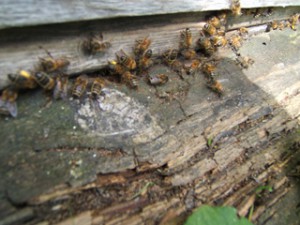 Well, it’s been another bumper year for the bees – though it’s not over yet by a long way. The weather has been hot, with rain from time to time rather than all the time, which has meant plants have, in the main, been able to secrete nectar which the bees have gathered to convert to honey.
Well, it’s been another bumper year for the bees – though it’s not over yet by a long way. The weather has been hot, with rain from time to time rather than all the time, which has meant plants have, in the main, been able to secrete nectar which the bees have gathered to convert to honey.
I have removed the crop from most of my hives by now, though there are still three with honey-filled combs that need bringing in before the bees take the honey down into their brood box ready for the winter – but if they do, their need must be greater than mine, so fair enough.
I noticed today that some of the ivy in the trees around my main home apiary is flowering, which accounts for the continuing frenzied activity I see outside the hives and the dull yellow pollen loads on the bees’ back legs. There appears to have been virtually no let-up of nectar flow since back in April, whereas normally we expect to see the bees’ foraging activity fall off in June and from the middle of August to the middle of September or later.
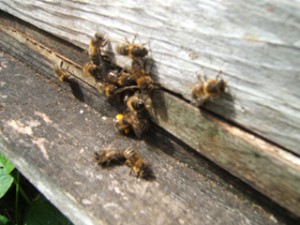 The former is what was once called the “June gap”, when bees could starve at a time when they had used up all the honey they had made since the beginning of the season in raising their ever-expanding brood nest at the height of the season and when there was nothing in the fields for them to bring home.
The former is what was once called the “June gap”, when bees could starve at a time when they had used up all the honey they had made since the beginning of the season in raising their ever-expanding brood nest at the height of the season and when there was nothing in the fields for them to bring home.
The later gap is between the end of the “main flow” (clover and bramble, mainly) and the beginning of the ivy flowering, which could be any time between the beginning of September or October. Our climate is definitely changing and seasons are more ill-defined than they once were.
Luckily, the bees are adaptable and are able to take advantage of a year such as this to maximise their income. They will have adequate stores in their brood box from the main flow and will top this up, as it is used to feed the developing “winter” bees, with the nectar and pollen from ivy. Brilliant! No artificial feeding required once again, meaning that the bees will have a balanced diet of natural rather than manufactured products to see them through the winter.
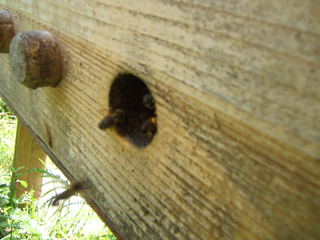 I don’t know if this is the case for everyone this year but I’ve seen very few wasps around. Having said that, I have one hive at home which is a weak colony, though with a new queen, which was being robbed prodigiously by wasps – and bees.
I don’t know if this is the case for everyone this year but I’ve seen very few wasps around. Having said that, I have one hive at home which is a weak colony, though with a new queen, which was being robbed prodigiously by wasps – and bees.
I must confess, though, that this was partly my fault, since, on adding an extracted super for the bees to clean up the last vestiges of honey that couldn’t be extracted, and having to do this when it was virtually dark so the bees didn’t come out in search of this “honey very close to the hive”, I left a gap at the back of the hive between the super and the brood box!
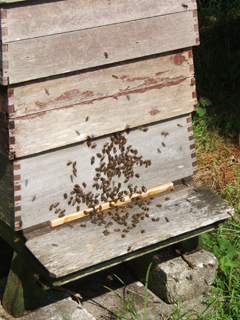 The following morning when I went to check all was in order, there was mayhem around the hive with hundreds of bees and several wasps coming and going through this gap at the back.
The following morning when I went to check all was in order, there was mayhem around the hive with hundreds of bees and several wasps coming and going through this gap at the back.
I immediately closed up the gap and closed the hive entrance totally to prevent any other robbers from gaining access. I had to leave it like that for two days, then cautiously opened the entrance to “one bee space” width round about midday and closed it again at 5 o’clock, since the wasps in particular are looking to gain access early and late in the day when the bees are all inside clustering to keep warm, so there are no guards at the entrance to see them off.
I left the hive closed for another two days and repeated this for about ten days. As wasps settled by the closed entrance, especially in the evening, I squashed them in situ, which, coupled with several wasp traps I surrounded the hive with, kept them out of the hive and reduced their numbers considerably. After two weeks, the colony is now at a point where it can fend for itself and the entrance is open, at a “two bee width”, all the time. Pollen is coming in and the bees are working very busily bringing in nectar, so “I think we’ve got away with it”, to quote John Cleese!
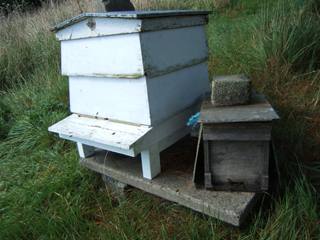 One of the problems with robbing is that the robbers seem to leave a pheromone signal at the entrance which says “easy pickings” and it is very difficult to overcome this situation. In fact, this is the first time in my beekeeping career that I have been so successful in achieving such a recovery, so I am well pleased – for the bees as much as for me!
One of the problems with robbing is that the robbers seem to leave a pheromone signal at the entrance which says “easy pickings” and it is very difficult to overcome this situation. In fact, this is the first time in my beekeeping career that I have been so successful in achieving such a recovery, so I am well pleased – for the bees as much as for me!
Another thing that has pleased me greatly is another report from FERA (which oversees the Bee Inspectorate) which shows that I had no Varroa in the hive debris I sent off for analysis this summer. You may remember that this also happened last year, with another colony.
Bearing in mind that I only use icing sugar as my Varroa treatment, I feel vindicated in my approach to Varroa control – no chemicals in my hives, thank you very much! However, I won’t let my guard down, otherwise the Varroa mites might come back and bite me in the you know where”!
What with more honey extraction, and Varroa treatments for the last three colonies, together with moving my remaining nuclei onto full brood box set-ups before the middle of September, the season is far from over for us beekeepers. After that there is then the removal of any surplus ivy honey, should there be any. Hey, ho, who’s for the easy life?
Colin Rees – colinbeeman@aol.com – 01872 501313

